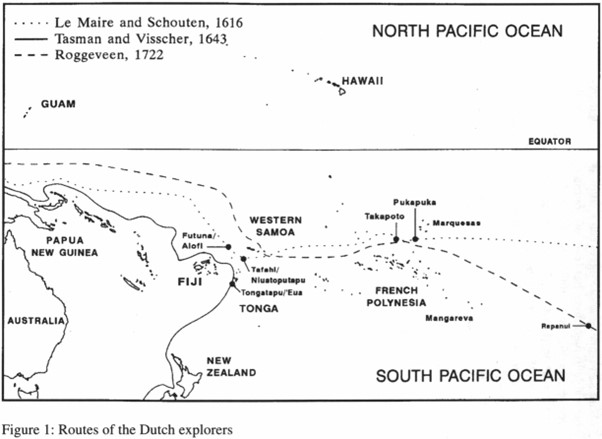The Polynesian islands share in common the fact that the first European language they came into contact with was the English brought first by Captain Cook, spread by whalers and traders and later consolidated by missionaries.
The purpose of the paper below is twofold. First, the authors will present evidence that, contrary to claims such as the above, the honour of being the first European language to contribute to Polynesian vocabularies falls not to English, but to Dutch, the language of some of the earliest European explorers of the Pacific. They will demonstrate that at least three words that have been considered indigenous are in fact early Dutch loanwords, two dating from either Le Make and Schouten’s 1616 visit to Nivatoputapu and Futuna, or Tasman’s 1643 visit to Tonga, and the third from Roggeveen’s 1722 visit to the Thamotus. Secondly, the subsequent spread of the 17th century loanwords throughout much of Polynesia provides additional evidence of the extent of Polynesian inter-island voyaging before Cook.
Historical Background
In the 16th century, the European exploration of the South Pacific was almost entirely the domain of the Spanish (Mendafia 1567-1569, Mendaria-Quiros 1595-1596, Quiros 1605-1606, Torres 1606-1607). This changed, however, in the early years of the 17th century when the Dutch ventured into the South Pacific in search of new markets and the great southland. The most significant of the Dutch expeditions were those of Jacob Le Maim and Willem Coneliszoon Schouten in 1615-1617, Abel Janszoon Tasman and Franchoys Jacobszoon Visscher in 1642-1643, and Jacob Roggeveen, Corneliszoon Bauman, Roelof Rosendaal and Jan Koster in 1721-1722 (see map below). There were a number of other Dutch expeditions during this period (Jacob Mahu and De Cordes 1598-1600, Oliver van Noort 1598-1601, Joris van Spilbergen 1614-1617, Jacob l’Hermite 1624-1625), but none of these ventured south of the Line.

More information on, and publications from Linguist Dr. Jan Trent


